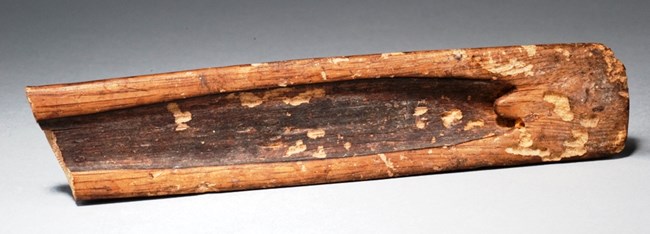Who were the Mogollon?The people who built the dwellings are called the Tularosa Mogollon, however an important clarification to make is that this name was given to them by archeologists. The name comes from the Mogollon mountain range in the Gila Wilderness which was named after the Governor of Sante Fe de Nuevo Mexico Don Juan Ignacio Flores Mogollon who served as governor from 1712 to 1715. Why did they come here?Unfortuantly we don't know the exact reason why they came here, however we have a strong reason to believe that they occupied the dwellings to seek relief from a drought, specifically the Great Drought of 1270-1300, which roughly lines up with the entire occupation of the Gila Cliff Dwellings. 
NPS Photo/WAAC How long were the dwellings occupied?Archeologists believe that the dwellings were occupied for roughly 30 years, from the 1270s through the early 1300s. Dendrochronology was used to determine the years of occupation. Tree rings indicate the year the tree was cut not the year the people began to build. Although scientist discovered the earliest cut date of 1276 CE, that does not necessarily mean that that was the year they began construction.It is worth noting that the Tularosa Mogollon were not the first people to occupy these caves. Soot deposits on the roofs of the caves represents thousands of years’ worth of human occupation. Archaic hunter gathers utilized these caves as a part of their seasonal migrations as indicated by the atlatl fragments, the hunting weapon of choice of the Archaic people, that was found in the dwellings during the archeological excavations. Why were these caves chosen by the Tularosa Mogollon?There are many reasons archeologists believe that these caves were chosen to provide a home for the Tularosa Mogollon people that occupied them. First off, the caves provide a natural form of protection from the elements. The southern facing caves also provide excellent temperature regulation in both the winter and summer months.In addition, the canyon that lies below the caves has a stream that runs year-round, and the canyon's numerous plants that could be used for many purposes one such plant is Yucca. Yucca could be ground up into a shampoo, and there were a pair of yucca sandals that were found in the monument. There are also numerous plants that produce edible fruits and/or nuts these include Pinon Pine, grapes, oak trees, Prickly Pear Cactus and more. In addition to plants, animals seemed to have been plentiful during the time of occupation. Animals like Mule Deer, Elk, Bison and more were hunted and/or to supplement their diet. Where did they go, and why did they leave?Unlike what is commonly told these people did not just disappear. While we do not exactly where these people went, we do know that they spread out into other pueblos across southwest New Mexico and Mexico. There are many theories of why they left including the end of The Great Drought of 1270-1300. They may have also left due to an overuse of resources.What was found in the dwellings?Many things were found in the dwellings and it's impossible to list it all on this one page, however some of the things that were found were remains of animals including Mule deer, Rabbit, Coyote, Bison and even a Mountain Lion. Numerous bird feathers were also found in the dwellings which included the Greater Roadrunner, Scarlet Macaw, Turkey, Great Horned Owl, Northern Flicker, as well as the Acorn Woodpecker.In addition pottery shards that survived the many years of looting and vandalism were also found in the dwellings. Corn cobs were found throughout the dwellings and can even still be seen today! Due to the protection provided by the caves these corn cobs have been able survive hundreds of years. What did they use for construction?The Mogollon used numerous items for construction. This included slabs of Gila Conglomerate, wood, and a sandy clay as a mortar.They used various types of wood that included Ponderosa Pine, Douglas Fir, Juniper, and Cottonwood. |
Last updated: January 29, 2024
